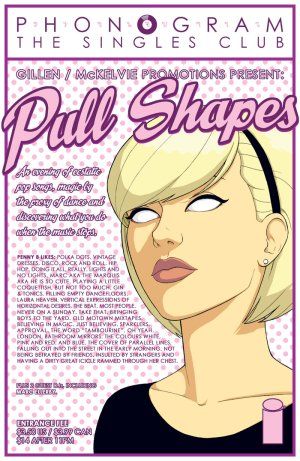This week sees the return of "Phonogram." Or, as you might remember it: That Britpop Comic. Far from being about Britpop, though, the second series of "Phonogram" promises to explore the "Music is magic" idea in a completely different way to the original. Over the course of seven single-issue stories, each issue of this series will follow a different Phonomancer's adventures in the same club on the same night, leaving us with one giant interlocking tapestry of stories.
Issue #1 stars Penny B, a 4th-wall bending Phonomancer who, in her own words, dances -- and exactly what that means is dealt with over the course of the story, using the light fantasy twist you can expect from Phonogram. While it works as a self-contained issue, certain elements of the plot go unexplained just enough to make you aware that there's more going on under the surface. Full illumination of the night's events will surely follow as the series progresses, and that makes this issue a fairly bold opener -- Penny's plot holds it together well, and the deliberately obscured elements are intriguing, rather than distracting. It's a difficult balance that Gillen thankfully manages to achieve.
The lead story is illustrated by original series artist Jamie McKelvie, whose artwork now sports the same vivid color palette seen earlier this year in his solo series, "Suburban Glamour." This is a good-looking comic, with pure, direct storytelling balanced by rich backgrounds and stunning attention to detail in terms of fashion, body language and environment. The reader is ambitiously (and successfully) cast in the role of Penny's companion as she acts as a kind of dance floor Virgil, occasionally guiding us through her world in a uniquely immersive reading experience. It takes a careful balance of art and writing to pull something this experimental off, and Gillen and McKelvie manage it beautifully.
While debate rages about whether $3.99 is too much to pay for a comic, one issue of "Phonogram" (costing $3.50) will net you, in this case, a feature-length story, two multi-page back-up strips and Gillen's trademark essay/annotation text pages -- and most of that won't even make it to the trade collection. Once again, "Phonogram" straddles the boundary between comic and fanzine, offering brilliant value.
Marc Ellerby gets the plum assignment of illustrating a "B-Side" featuring the obvious breakout stars of this series, Seth Bingo and the Silent Girl, and turns in an instantly lovable 2-page humor piece. Elsewhere, Laurenn McCubbin helps takes the series to its most American extreme yet, placing a certain type of Emo music under the Phonogram microscope in a 4-page horror short. The backup stories may be over quick, but you can only enjoy their novelty even as they expand the Phonogram universe. The "B-Side" metaphor stretches appropriately far -- you're likely to find yourself crushing hard on some of these shorts in months to come, perhaps even above the more finely-produced "singles."
"Phonogram 2" ultimately represents a huge leap forward for both Gillen and McKelvie's craft and the audience the series is capable of reaching. That said, the subject matter and sheer weight of the metaphor means that not everyone's going to "get" the series -- the rest of us, though, can content ourselves with pining for issue 2.

